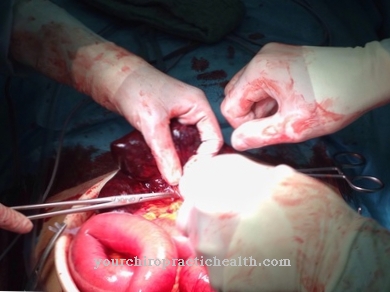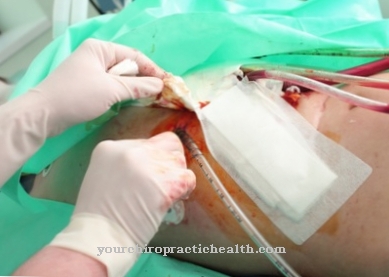At a lumbar sympathectomy it is a form of surgical nerve block. It is used to treat hyperhidrosis or pain.
What is the Lumbar Sympathectomy?

A lumbar sympathectomy is used when certain ganglia of the sympathetic nervous system in the lumbar spine region are severed as part of a surgical procedure. The severing can be done either in part or completely.
The sympathetic nervous system is part of the autonomic nervous system and is the antagonist of the parasympathetic nervous system. It fulfills the task of regulating the metabolism, heart and circulation. In addition, it ensures a higher performance of the body.
Another function of the sympathetic system is to stimulate perspiration. In the case of a lumbar sympathectomy, there is the option of blocking the sympathetic nerve, which will reduce excessive perspiration.
The lumbar sympathetic blockade on the lumbar spine is also suitable for the treatment of chronic pain conditions. Both an open and an endoscopic lumbar sympathectomy are possible.
Function, effect & goals
In contrast to endoscopic thoracic sympathectomy (ETS), which is performed to treat sweating on the face and hands, the lumbar sympathetic block is used to treat plantar hyperhidrosis on the feet. While the thoracic sympathectomy involves severing or partially removing the trunk in the chest, the endoscopic lumbar sympathectomy (ELS) is performed in the region of the lumbar spine.
A minimally invasive approach using a special endoscope is possible for both procedures. Surgical sympathectomy is only performed, however, if all other therapy options do not lead to the desired effect.
By blocking the sympathetic nervous system in the lumbar region, pain can also be effectively treated. This is especially true for painful conditions in the lower limbs. The pain is either significantly alleviated or even completely eliminated. When treating pain, the nerves can be influenced by the administration of an active ingredient (sympatholytic).
The surgeon places the drug in the neighboring vein, which improves blood flow to the muscles and other body structures. This leads to a reduction in pain. A long-term effect is even possible if several sessions take place. The control of the operation process takes place under ultrasound or X-ray supervision. In this way, the surgeon can lead a long needle into the vicinity of the sympathetic trunk and numb it with it.
In addition to plantar hyperhydrosis, the main indications for a thoracic sympathectomy are pain due to circulatory disorders, nervous disorders and a complex regional pain syndrome. For the effective treatment of plantar hyperdhidrosis, it is necessary to eliminate or at least reduce the perspiration that occurs on the feet. To do this, the surgeon cuts the sympathetic trunk, which is at the level of the lumbar spine. Its course extends from the large blood vessels such as the main artery (aorta) to the anterior lumbar spine.
Since the sympathetic nerve is difficult to access, complex open operations were necessary in previous years. The patient's recovery phases lasted several weeks. For several years, however, the gentle endoscopic lumbar sympathectomy has been one of the common surgical procedures that involve video endoscopy. The access is created on both sides through three smaller skin incisions in the side area of the navel level. After the sympathetic nervous system has been blocked, the patient only needs to remain in the hospital for 24 hours.
The postoperative recovery phase is now also limited to a few days. However, the surgeon's experience makes a decisive contribution to the success of the operation. Basically an endoscopic lumbar sympathectomy takes place nowadays. In contrast, open interventions are only used in exceptional cases. Since this procedure is an extremely complicated procedure, it only takes place in a few specialized centers.
You can find your medication here
➔ Drugs against sweating and sweatingRisks, side effects & dangers
Endoscopic lumbar sympathectomy can sometimes lead to undesirable side effects and complications. Similar to endoscopic thoracic sympathectomy in the chest, compensatory sweating is possible after the operation. In most patients, however, the extent of this side effect is much less pronounced. Some patients, who primarily include people who have already undergone thoracic surgery, hardly feel this effect.
Another possible side effect is the increase in peripheral blood flow in the feet. This circumstance is noticeable when the feet are too dry and too warm. Occasionally, the feet also swell, but this is only temporary. The complication of retrograde ejaculation in men, in which the seminal fluid no longer empties outwards, has become rather rare. It shows up primarily after open sympathectomies. With the introduction of the more precise endoscopic lumbar sympathectomy, however, this unpleasant side effect could be significantly reduced.
Occasionally, anatomical problems arise during the procedure. For example, scarring tissue may prevent access to the sympathetic nerve due to inflammation, bleeding or visual impairments. In such cases, the doctor will cancel the operation or alternatively select an open approach.
Basically, the disruption of the sympathetic nerve leads to a significant improvement in the hyperhidrosis on the feet. The success rate is around 99 percent. In some cases, however, the ganglion chain cannot be passed at all, which is due to inflammatory processes or adhesions that formed after previous interventions. In addition, the anatomy of the patient can be different. Therefore the surgeon often has to proceed individually.













.jpg)

.jpg)
.jpg)











.jpg)